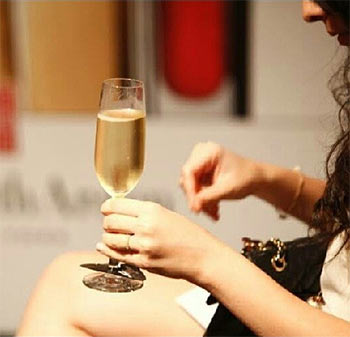 | « Back to article | Print this article |
Raise a toast to good health with wine. But this time, says Alok Chandra, let's go for the desi ones.

Not so long ago, there was no Indian wine priced above Rs 500 per bottle (of 750 ml), and no imported wine below that level.
How times have changed -- today, the Zampa Chene Grand Reserve (a red wine) is on offer in Bengaluru at Rs 1,850, while the Grover La Reserve (which used to be at Rs 450 just 10 years back) is now Rs 1,000.
The majority of wines on sale by the better-known Indian wineries are priced today at above Rs 600, and everyone has increased prices in 2016 by 10 per cent to 20 per cent.
"Oh, but that's not even $10 per bottle," some might well remark. Well, that's okay if one is earning in dollars, but for the vast majority of the consuming populace this is a premium pricing that inhibits offtake.
Indians are among the most price-conscious consumers in the world, a fact recognised by that Maruti TV ad where the protagonist asked 'Kitna deti hai?' ('What's the mileage?')
We query 'Kitna padta hai?/ ('How much does it cost?') when exploring any purchase, and it is well known that most Indians first scrutinise the right hand side of a menu (where prices are given) when deciding what to order.
So what's led to this 'premiumisation' of prices of Indian wines?
As always, it's a combination of strong demand for better wines, together with constraints in the supply of decent-quality wine grapes which has pushed their cost upwards.
There is no doubt that the quality of many Indian wines has been improving over time due to better viticultural practices yielding better quality wine grapes as well as improved winemaking and the use of oak casks to mature some reds.
Prices of the best Indian wines are hence benchmarked against those of imported wines which suffer double taxation in India -- customs duties (currently about 162 per cent) and state excise duties (which should really be exempt but which states impose in various guises).
Consumers are starting to recognise that the best domestic wines give a better QPR (Quality Price Ratio) than imported wines at comparative prices; hence the strong demand.

The top three wineries in India today by volume are Sula (850,000 cases in 15/16), Grover-Zampa (150,000 cases) and Fratelli (estimated 100,000 cases).
All three have wine portfolios spanning a wide spectrum of prices and quality levels -- Sula from the Port 1000 (Rs 160) to the Sula Rasa Shiraz (Rs 1,395), Grover-Zampa from Red Lips Port (Rs 86) to the previously mentioned Zampa Chene (Rs 1,850) and Fratelli from its Sidus Range (Rs 200/250) up to the Sette (Rs 1,642).
There is also the boutique Krsma Estate near Hampi in North Karnataka (3,000 cases sold between Bengaluru and New York) whose range starts with the K2 (Rs 780) and extends to its flagship Cabernet Sauvignon (Rs 1,500).
On the supply side, this was a good year for grape growers as demand outstripped supply in Maharashtra, leading to prices for even Chenin Blanc (the most widely grown white wine grape) touching Rs 40 per kg (as compared to Rs 25 to 30 in 2015) and going up to Rs 80 per kg for the red varietals (Cabernet Sauvignon and Shiraz).
New plantings take two to three years to start delivering fruit, so the high prices are expected to continue till 2018, something that wine producers have factored into their pricing strategies.
Wine I've been drinking

Four of the best Sula wines -- Rasa Shiraz 2014, Dindori Reserve Shiraz 2014 (Rs 1,030), Dindori Reserve Viognier 2015 (Rs 810) and the Sula Riesling 2015 (Rs 830) at a tasting conducted by its new vice-president (marketing) Cecelia Oldne.
While I was most impressed by the Riesling, a grape that normally thrives only in cold temperate places and almost impossible to grow in our warm tropical climate.
The wine is very aromatic (lychee, grapefruit, nuts and honey) and a delicious citrus taste that is actually dry while seeming to be a bit sweet.
Well balanced, this would be a perfect match for both Indian as well as Oriental cuisines.
Alok Chandra is a Bengaluru-based wine consultant.
Lead photograph: Kind Courtesy Grover Zampa Vineyards/Instagram